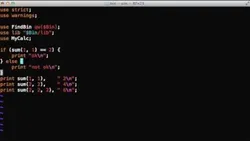
Test Automation with Perl 
This course introduces Test::Simple for testing Perl programs. It covers refactoring large test suites, separating test data from test code, and using diag, note, and explain for test diagnostic messages. It also covers testing dice with multiple expected values and test timeout in Perl with cmp_ok. Students will learn how to write effective tests for their Perl programs. ▼
ADVERTISEMENT
Course Feature
![]() Cost:
Cost:
Free
![]() Provider:
Provider:
Youtube
![]() Certificate:
Certificate:
Paid Certification
![]() Language:
Language:
English
![]() Start Date:
Start Date:
On-Demand
Course Overview
❗The content presented here is sourced directly from Youtube platform. For comprehensive course details, including enrollment information, simply click on the 'Go to class' link on our website.
Updated in [May 25th, 2023]
Test Automation with Perl is a course designed to introduce students to Test::Simple, a testing framework for Perl programs. Students will learn how to refactor large test suites in Perl, separate test data from test code, and test diagnostic messages using diag, note, and explain. Additionally, students will learn how to test multiple expected values, such as testing dice, and how to use cmp_ok to test timeouts in Perl.
[Applications]
After this course, participants can apply the knowledge they have gained to create automated tests for their Perl programs. They can use Test::Simple to create tests and refactor large test suites. They can also separate test data from test code, and use diag, note, and explain to test diagnostic messages. Additionally, they can use cmp_ok to test for multiple expected values and timeouts.
[Career Paths]
1. Automation Test Engineer: Automation Test Engineers are responsible for designing, developing, and executing automated tests to ensure the quality of software applications. They use scripting languages such as Perl to create automated tests and analyze the results. Automation Test Engineers are also responsible for maintaining and updating existing automated tests. As the demand for software applications increases, the need for Automation Test Engineers is expected to grow.
2. Software Quality Assurance Engineer: Software Quality Assurance Engineers are responsible for ensuring the quality of software applications. They use scripting languages such as Perl to create automated tests and analyze the results. They also review software requirements, design documents, and code to ensure that the software meets the required standards. As software applications become more complex, the need for Software Quality Assurance Engineers is expected to increase.
3. Software Developer: Software Developers are responsible for designing, developing, and testing software applications. They use scripting languages such as Perl to create automated tests and analyze the results. They also review software requirements, design documents, and code to ensure that the software meets the required standards. As software applications become more complex, the need for Software Developers is expected to increase.
4. DevOps Engineer: DevOps Engineers are responsible for automating the software development process. They use scripting languages such as Perl to create automated tests and analyze the results. They also review software requirements, design documents, and code to ensure that the software meets the required standards. As software applications become more complex, the need for DevOps Engineers is expected to increase.
[Education Paths]
1. Bachelor of Science in Computer Science: This degree path provides students with a comprehensive understanding of computer science fundamentals, including programming languages, software engineering, computer architecture, and operating systems. Students will also learn about the latest trends in computer science, such as artificial intelligence, machine learning, and data science.
2. Bachelor of Science in Software Engineering: This degree path focuses on the development of software applications and systems. Students will learn about software design, development, testing, and maintenance. They will also gain an understanding of the principles of software engineering, such as software architecture, software development life cycle, and software quality assurance.
3. Master of Science in Computer Science: This degree path provides students with an advanced understanding of computer science topics, such as algorithms, data structures, computer networks, and distributed systems. Students will also learn about the latest trends in computer science, such as artificial intelligence, machine learning, and data science.
4. Master of Science in Software Engineering: This degree path focuses on the development of software applications and systems. Students will learn about software design, development, testing, and maintenance. They will also gain an understanding of the principles of software engineering, such as software architecture, software development life cycle, and software quality assurance. Additionally, students will learn about the latest trends in software engineering, such as cloud computing, mobile computing, and web development.
Course Provider

Provider Youtube's Stats at AZClass
Discussion and Reviews
0.0 (Based on 0 reviews)
Explore Similar Online Courses

Python Coding Projects Build a Web App Login Brute-Force

JavaScript Fundamentals

Python for Informatics: Exploring Information

Social Network Analysis

Introduction to Systematic Review and Meta-Analysis

The Analytics Edge

DCO042 - Python For Informatics

Causal Diagrams: Draw Your Assumptions Before Your Conclusions

Whole genome sequencing of bacterial genomes - tools and applications

Introduction to Perl IRL

Perl Scripting Online Training

RHEL 8: Operating Running Systems
 Related Categories
Related Categories
 Popular Providers
Popular Providers
Quiz
 Submitted Sucessfully
Submitted Sucessfully
1. Which of the following is a feature of Test::Simple?
2. Which of the following is NOT a feature of Test::Simple?


Start your review of Test Automation with Perl